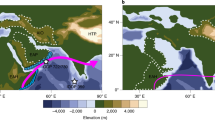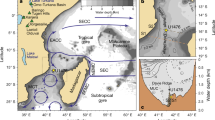Abstract
The Benguela Current, located off the west coast of southern Africa, is tied to a highly productive upwelling system1. Over the past 12 million years, the current has cooled, and upwelling has intensified2,3,4. These changes have been variously linked to atmospheric and oceanic changes associated with the glaciation of Antarctica and global cooling5, the closure of the Central American Seaway1,6 or the further restriction of the Indonesian Seaway3. The upwelling intensification also occurred during a period of substantial uplift of the African continent7,8. Here we use a coupled ocean–atmosphere general circulation model to test the effect of African uplift on Benguela upwelling. In our simulations, uplift in the East African Rift system and in southern and southwestern Africa induces an intensification of coastal low-level winds, which leads to increased oceanic upwelling of cool subsurface waters. We compare the effect of African uplift with the simulated impact of the Central American Seaway closure9, Indonesian Throughflow restriction10 and Antarctic glaciation11, and find that African uplift has at least an equally strong influence as each of the three other factors. We therefore conclude that African uplift was an important factor in driving the cooling and strengthening of the Benguela Current and coastal upwelling during the late Miocene and Pliocene epochs.
This is a preview of subscription content, access via your institution
Access options
Subscribe to this journal
Receive 12 print issues and online access
$259.00 per year
only $21.58 per issue
Buy this article
- Purchase on Springer Link
- Instant access to full article PDF
Prices may be subject to local taxes which are calculated during checkout





Similar content being viewed by others
References
Hay, W. W. & Brock, J. C. Temporal variation in intensity of upwelling off southwest Africa. Geol. Soc. London Spec. Publ. 64, 463–497 (1992).
Rommerskirchen, F., Condon, T., Mollenhauer, G., Dupont, L. & Schefuss, E. Miocene to Pliocene development of surface and subsurface temperatures in the Benguela Current system. Paleoceanography 26, PA3216 (2011).
Rosell-Mele, A., Martinez-Garcia, A. & McClymont, E. L. Persistent warmth across the Benguela upwelling system during the Pliocene epoch. Earth Planet. Sci. Lett. 386, 10–20 (2014).
Marlow, J. R., Lange, C. B., Wefer, G. & Rosell-Mele, A. Upwelling intensification as part of the Pliocene-Pleistocene climate transition. Science 290, 2288–2291 (2000).
Diekmann, B., Falker, M. & Kuhn, G. Environmental history of the south-eastern South Atlantic since the Middle Miocene: Evidence from the sedimentological records of ODP Sites 1088 and 1092. Sedimentology 50, 511–529 (2003).
Prange, M. & Schulz, M. A coastal upwelling seesaw in the Atlantic Ocean as a result of the closure of the Central American Seaway. Geophys. Res. Lett. 31, L17207 (2004).
Roberts, G. G. & White, N. Estimating uplift rate histories from river profiles using African examples. J. Geophys. Res. 115, B02406 (2010).
Chorowicz, J. The East African rift system. J. Afr. Earth Sci. 43, 379–410 (2005).
Zhang, X. et al. Changes in equatorial Pacific thermocline depth in response to Panamanian seaway closure: Insights from a multi-model study. Earth Planet. Sci. Lett. 317, 76–84 (2012).
Krebs, U., Park, W. & Schneider, B. Pliocene aridification of Australia caused by tectonically induced weakening of the Indonesian throughflow. Palaeogeogr. Palaeoclimatol. Palaeoecol. 309, 111–117 (2011).
Goldner, A., Huber, M. & Caballero, R. Does Antarctic glaciation cool the world? Clim. Past 9, 173–189 (2013).
Nicholson, S. E. A low-level jet along the Benguela coast, an integral part of the Benguela Current ecosystem. Climatic Change 99, 613–624 (2010).
Burk, S. D. & Thompson, W. T. The summertime low-level jet and marine boundary layer structure along the California coast. Mon. Weath. Rev. 124, 668–686 (1996).
Nyblade, A. A. & Robinson, S. W. The African Superswell. Geophys. Res. Lett. 21, 765–768 (1994).
Seranne, M. & Anka, Z. South Atlantic continental margins of Africa: A comparison of the tectonic vs climate interplay on the evolution of equatorial west Africa and SW Africa margins. J. Afr. Earth Sci. 43, 283–300 (2005).
Moucha, R. & Forte, A. M. Changes in African topography driven by mantle convection. Nature Geosci. 4, 707–712 (2011).
Pik, R. East Africa on the rise. Nature Geosci. 4, 660–661 (2011).
Erlanger, E. D., Granger, D. E. & Gibbon, R. J. Rock uplift rates in South Africa from isochron burial dating of fluvial and marine terraces. Geology 40, 1019–1022 (2012).
Roberts, E. M. et al. Initiation of the western branch of the East African Rift coeval with the eastern branch. Nature Geosci. 5, 289–294 (2012).
Sepulchre, P. et al. Tectonic uplift and Eastern Africa aridification. Science 313, 1419–1423 (2006).
Al-Hajri, Y., White, N. & Fishwick, S. Scales of transient convective support beneath Africa. Geology 37, 883–886 (2009).
Cohen, A. S., Soreghan, M. J. & Scholz, C. A. Estimating the age of formation of lakes — an example from Lake Tanganyika, East-African Rift system. Geology 21, 511–514 (1993).
Sepulchre, P., Sloan, L. C., Snyder, M. & Fiechter, J. Impacts of Andean uplift on the Humboldt Current system: A climate model sensitivity study. Paleoceanography 24, PA4215 (2009).
Collins, W. D. et al. The community climate system model version 3 (CCSM3). J. Clim. 19, 2122–2143 (2006).
Holt, T. R. Mesoscale forcing of a boundary layer jet along the California coast. J. Geophys. Res. 101, 4235–4254 (1996).
Large, W. G. & Danabasoglu, G. Attribution and impacts of upper-ocean biases in CCSM3. J. Clim. 19, 2325–2346 (2006).
Dekens, P. S., Ravelo, A. C. & McCarthy, M. D. Warm upwelling regions in the Pliocene warm period. Paleoceanography 22, PA3211 (2007).
Oleson, K. W. et al. Improvements to the Community Land Model and their impact on the hydrological cycle. J. Geophys. Res. 113, G01021 (2008).
Grodsky, S. A., Carton, J. A., Nigam, S. & Okumura, Y. M. Tropical Atlantic biases in CCSM4. J. Clim. 25, 3684–3701 (2012).
Veitch, J., Penven, P. & Shillington, F. Modeling equilibrium dynamics of the Benguela Current system. J. Phys. Oceanogr. 40, 1942–1964 (2010).
Acknowledgements
This work was funded by the Deutsche Forschungsgemeinschaft (DFG) Research Center/Excellence Cluster ‘The Ocean in the Earth System’. The authors would like to thank G. Strand (NCAR) for making available the spun-up pre-industrial control run restart files. Thanks also to B. Briegleb (NCAR) for making pre-industrial aerosol data available. Special thanks to X. Zhang (MARUM), A. Goldner (Purdue University), U. Krebs-Kanzow (AWI) and S. Khon (University of Kiel) for kindly making available data of additional model simulations of Panama closure, Antarctic glaciation and Indonesian Throughflow restriction. The CCSM3 experiments were run on the SGI Altix Supercomputer of the ‘Norddeutscher Verbund für Hoch- und Höchstleistungsrechnen’ (HLRN).
Author information
Authors and Affiliations
Contributions
M.P. and M.S. developed the project. G.J., M.P. and M.S. interpreted the model results and wrote the paper. G.J. performed the model simulations, analysed the model results and created the figures.
Corresponding author
Ethics declarations
Competing interests
The authors declare no competing financial interests.
Supplementary information
Supplementary Information
Supplementary Information (PDF 2923 kb)
Rights and permissions
About this article
Cite this article
Jung, G., Prange, M. & Schulz, M. Uplift of Africa as a potential cause for Neogene intensification of the Benguela upwelling system. Nature Geosci 7, 741–747 (2014). https://doi.org/10.1038/ngeo2249
Received:
Accepted:
Published:
Issue Date:
DOI: https://doi.org/10.1038/ngeo2249
This article is cited by
-
The influence of southeastern African river valley jets on regional rainfall
Climate Dynamics (2021)
-
Climatic and topographic changes since the Miocene influenced the diversification and biogeography of the tent tortoise (Psammobates tentorius) species complex in Southern Africa
BMC Evolutionary Biology (2020)
-
Warm bias of sea surface temperature in Eastern boundary current regions—a study of effects of horizontal resolution in CESM
Ocean Dynamics (2019)
-
Steps in the intensification of Benguela upwelling over the Walvis Ridge during Miocene and Pliocene
International Journal of Earth Sciences (2017)
-
Influence of topography on tropical African vegetation coverage
Climate Dynamics (2016)



